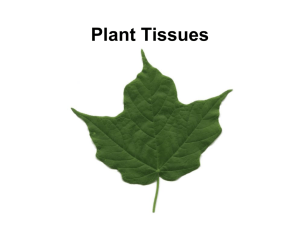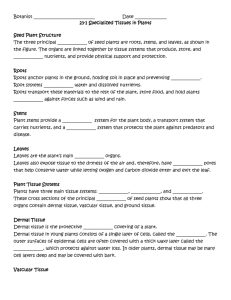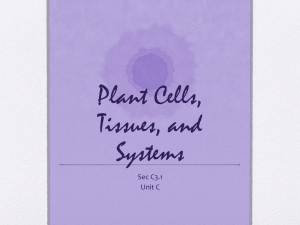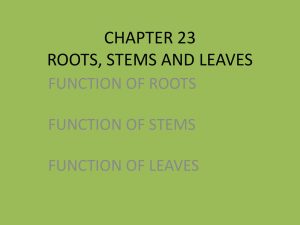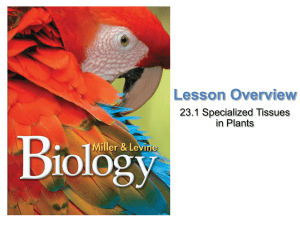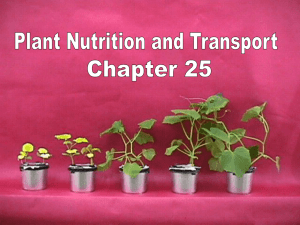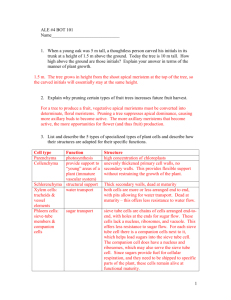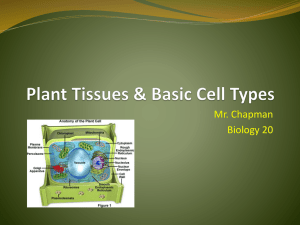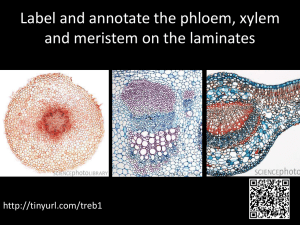bio 11 plant tissues dec 2
advertisement
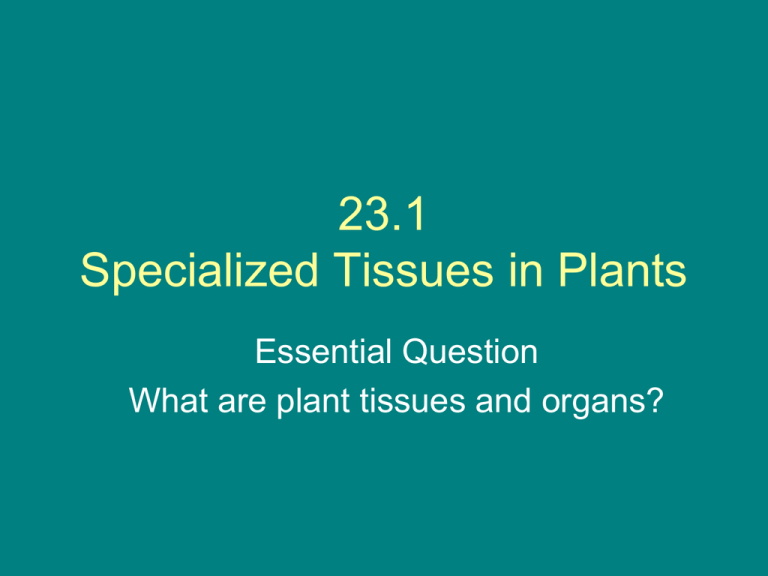
23.1 Specialized Tissues in Plants Essential Question What are plant tissues and organs? Seed Plant Structure • Three main organs of seed plants are roots, stems, and leaves • These organs are linked together by systems that transport nutrients, protect it, and coordinate activities Roots • Absorb and transport water and dissolved nutrients to rest of plant • Anchor plant in ground, holding soil in place, and preventing erosion • Keeps plants upright against forces such as wind and rain • Protects plant form harmful soil bacteria and fungi • Two types: fibrous and taproot Stems • Have three important functions: – Produce leaves, branches, and flowers – Hold leaves up to sunlight – Transport substances between roots and leaves Leaves • Principle organs in which plants carry out photosynthesis • Vary widely according to species • Have adjustable pores called stomata that help to conserve water and exchange gases Tissue Systems- 3 types • Dermal – outermost layer of cells functions to protect plant and exchange gases and water • Ground – cells that lie between the dermal and vascular systems • Vascular – transports water and nutrients throughout plant Dermal Tissue • Outermost layer of plant • Consists of single layer of epidermal cells • Often covered with waxy layer called the cuticle that protects against water loss and injury Dermal Cont’d • Some cells have projections called trichomes that help protect leaf and give it a fuzzy appearance • Root dermal tissue contains root hair cells that aid in absorption Dermal Cont’d • Underside of leaves have stomata which contain guard cells that regulate water loss and gas exchange Leaf Structure Vascular Tissue • Forms transport system m; conducts water and nutrients through plant • Made up of a network of hollow connected cells • Consists of: – xylem (water-conducting tissue) • consists of tracheids (conifers) and vessel elements (angiosperms only) – phloem (food conducting tissue). • Phloem consists of sieve tube elements and companion cells Tracheids • • • • • Found in all seed plants type of xylem cell Found first in fossil record Only xylem cell found in conifers and ferns long, narrow cells with walls made of lignin and cellulose that are impermeable to water • Walls are pierced with openings that connect them to other cells • Mature cells die and cytoplasm disintegrates Vessel elements • Only found in angiosperms • Conduct water • much wider than tracheids and are arranged end to end like stacked tin cans • Angiosperms have both tracheids and vessel elements but rely on vessel element to move water • Both types of cells mature and die before they can conduct water Compare Vessel element and Tracheid Phloem • Phloem tissue transports carbohydrates made during photosynthesis. • Made of sieve tube elements and companion cells • sieve tube elements are arranged end to end to form sieve tubes • Sieve tubes are mature cells that die and lose nuclei and most organelles • remaining organelles hug cell wall to form “pipeline” for movement of fluids. Cont’d • Ends of sieve tubes have many small holes to allow movement of sugars and other foods • Companion cells surround sieve tube elements and help support phloem cells and aid in movement of substances in and out of phloem Xylem and Phloem Vessel Cross Section of a Stem Ground Tissue • Made up of cells that lie between dermal and vascular tissues • Site of photosynthesis; helps support plants • May have three types of cells (depending on plant type) – parenchyma cells – thin cell walls and large central vacuole; in leaves are packed with chloroplasts • Function in storage and photosynthesis – collenchyma cells have thick strong flexible cell walls that help support larger plants – sclerenchyma cells have extremely thick, rigid cell walls that make ground tissue tough and strong. – Both collenchyma cells and sclerenchyma cells function as support Types of Cells in Ground Tissue Meristematic Tissue • Meristems are clusters of meristematic cells (undifferentiated cells) that are found in zones of the plant and help it grow throughout its entire life • Its function is to begin growth of new cells in seedlings at the tips of roots and shoots • Meristematic tissue produces meristems (meristematic cells) that are not yet specialized to perform specific functions (undifferentiated or embryonic) • Meristematic tissue is the only plant tissue that produces new cells by mitosis • Classified by location in plant: – apical meristems – found at the end or tip of growing roots and stems (shoots) – Lateral meristems -- found in the vascular cambium and cork cambium – intercalary meristems -- at internodes, or stem regions between the places at which leaves attach Plant Tissue Types Dermal tissue Vascular tissue Ground tissue Meristematic tissue Meristematic Tissue Root Meristem Differentiation • At first cells in meristem look alike • Then they divide rapidly and mature in a process called differentiation • Cells develop into each of the tissue systems of the plant (dermal, ground, and vascular)
